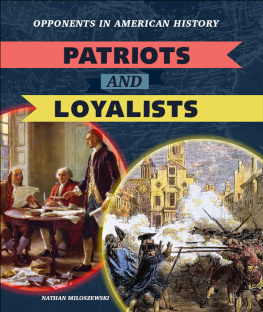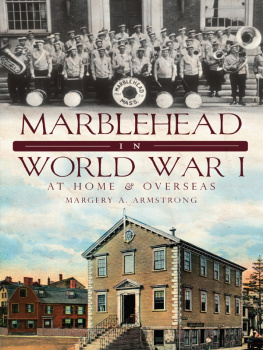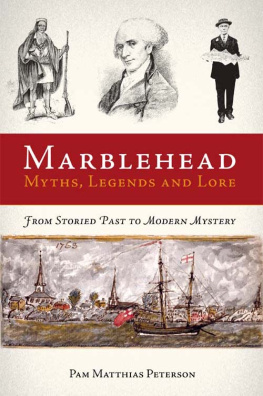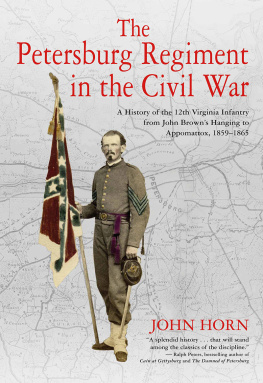PREFACE.
In Marblehead for thirty years, and more, after the Revolutionary War, the familiar forms of the veterans of that hard and long continued struggle were seen walking back and forth at the heads of the wharves, on Irvings Hill, or at the street corners, and the story they told of battles fought, of marches and of camp life was as familiar, throughout the town, to old and young, as any household words. But it was so evenly matched with the scenes of every day life, the hazards and storms at sea, of spars carried away and anchors lost and the vessel on beam-ends, of sailing to the Banks and never returning, that the two stories blended into one, and each life as a whole was a life of adventure, toil and danger; and rarely was a careful record made of passing events; so that many a story of real life, more thrilling than that of any fiction, has been forgotten and lost. When, about two years ago the Bronx Chapter of The Daughters of the American Revolution of Mount Vernon, N. Y., placed a bronze tablet on Glovers Rock, many asked: Where is Glovers Rock? and what does it mean? and were surprised to learn that it marked the spot where General Glover met the enemy, more than five times his number, and fought one of the most skilful and successful battles of the war. This aroused a long cherished wish of the author to follow General Glover and his regiment through the war of the Revolution. Under that inspiration the following paper was prepared and presented to the Marblehead Historical Society, May 14, 1903.
Glovers Rock, which in its vicinity has been known by that name since the days of the Revolution, is a great rock or boulder by the side of the road from Pelham to Pells Point. City Island is off the Point. The city of New York has recently acquired this whole territory of twenty-three hundred acres, in the midst of which is Glovers Rock, and set it apart as a public park to be known as Pelham Bay Park.
The road over which the British troops marched and on which Glover met them and fought the battle of Pells Point is still the highway from Pelham to the Point; and the stone wall, behind which he placed Read, Shepard and Baldwin, remained until a few years ago, when the road was macadamized. The stones were taken, broken and crushed to make the macadam, and when the street railway was built several cannon balls were dug from the earth near Glovers Rock.
June, 1903.
Gen. John Glover and his Marblehead Regiment in the Revolutionary War.
Charles Glover came from England to Salem in 1630. John Glover, who was born in Salem, and married Mary Guppy of Salem, January 2, 1660, is supposed to be the son of the immigrant Charles.
Jonathan, son of John, was born April, 1677, and married Abigail Henderson, March 31, 1697.
Jonathan, Jr., son of Jonathan, was born December 4, 1702, and married Tabitha Bacon, February 23, 1727.
The children of Jonathan, Jr., were:
Jonathan, born June 13, 1731, married Abigail Burnham of Marblehead, October 10, 1748, and was a hatter by trade.
Samuel, born June 13, 1731, married Mary Andrews of Marblehead, August 20, 1751, and was a goldsmith by trade.
John, born November 5, 1732, married first, Hannah Gale, October 30, 1754, second, Mrs. Frances Fosdick, both of Marblehead, and was by trade a shoemaker. (Hannah Gale was born in Marblehead, June, 1733, died November 13, 1778.)
Daniel, was born January, 1734, married Hannah Jillings of Newbury, December 1, 1757, and was a blockmaker by trade.
The following were the eleven children of John and Hannah Glover, all born in Marblehead:
st .John, born March 23, 1756. Married Fanny Lee, one child, Fanny.
nd .Hannah, born May 15, 1757. Died in infancy.
rd .Daniel, born April 8, 1759. Died in infancy.
th .Hannah, born April 19, 1761. Married Richard Cowell, seven children.
th .Samuel, born December 19, 1762. Married 1 st , Martha Bowden, 2 nd , Betsy Skillins, three children.
th .Jonas, born April 1, 1764. Married Sally Pierce, two children.
th .Tabitha, born December 8, 1765. Married William Brooks of Exeter.
th .Susannah, born March 28, 1767. Married Capt. Nicholas Broughton, five children.
th .Mary, born January 8, 1769. Married December 11, 1788, Robert Hooper, born February 3, 1766, thirteen children.
th .Sarah, born February 10, 1771. Married Samuel Lewis, one child.
th .Jonathan, born May 9, 1773. Died unmarried.
General John Glover with his three brothers, Jonathan, Samuel and Daniel, removed from Salem to Marblehead when young and soon became engaged in the various trades that they had previously learned.
John did not find the shoemakers bench and the last quite to his taste, while the fish-flakes, the warehouse and the wharf presented stronger attractions, promised larger returns and more nearly met his ambition.
He soon entered the fishing business, and pursued it with tact and energy. His market was largely in France, Spain and the West Indies, and this led him to engage in other mercantile pursuits. He was sagacious, energetic and successful.
At the outbreak of the Revolution he was forty-three years old, and for the times in which he lived he had accumulated quite a fortune.
Stryker, page 134, says: Glover owned a number of vessels, and before the war was extensively engaged in the fishing trade. He was an active and good soldier.
Dr. Coring before the Columbian Society, January 8, 1856, said: He was active, modest and industrious, the friend of Washington, the truest friend of freedom, the hero of Trenton. For many years he had been elected to offices of honor and trust and had served his fellow citizens in many ways.
The military spirit had always been strong in Marblehead. As early as 1758 a full militia regiment of a thousand men was maintained in this town, then the second in the colony of Massachusetts in point of wealth and importance.
When John Glover was elected Colonel of the Marblehead Regiment, he was not a novice in the military service, for he had held the following commissions, the originals of which are said to be still in possession of his descendants: Ensign in the third military foot company in the town of Marblehead, under the command of Richard Reed, Esq.; in the fifth regiment of militia in the County of Essex, whereof Jacob Fowle, Esq., is Colonel, and is dated March 12, 1759, and signed Thomas Pownall, Governor.















